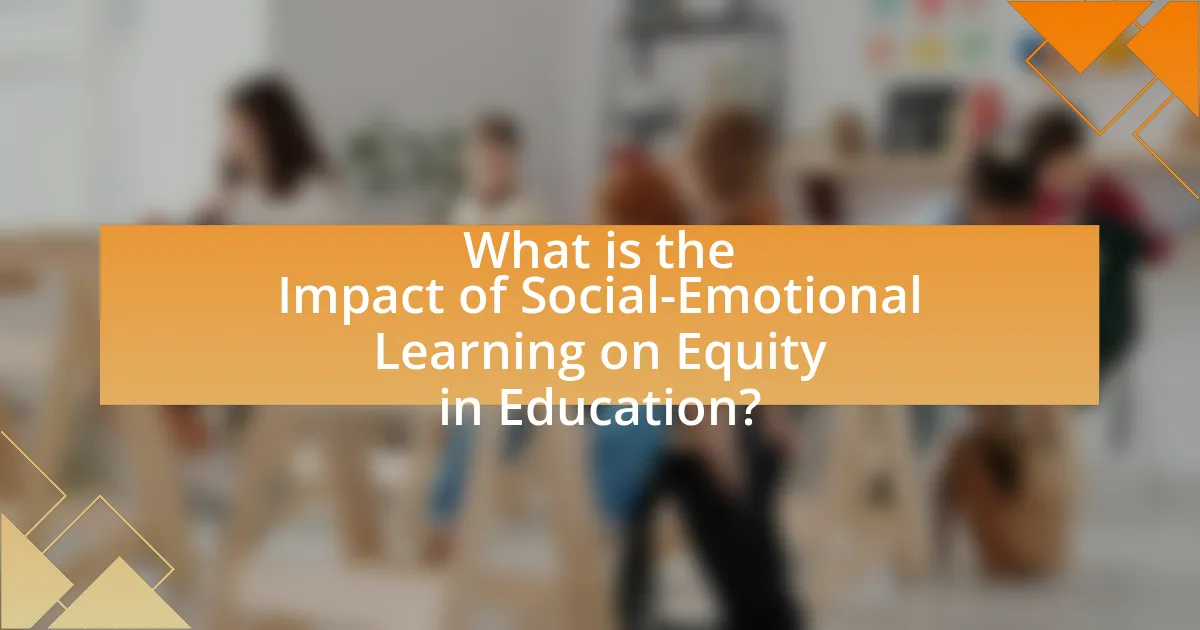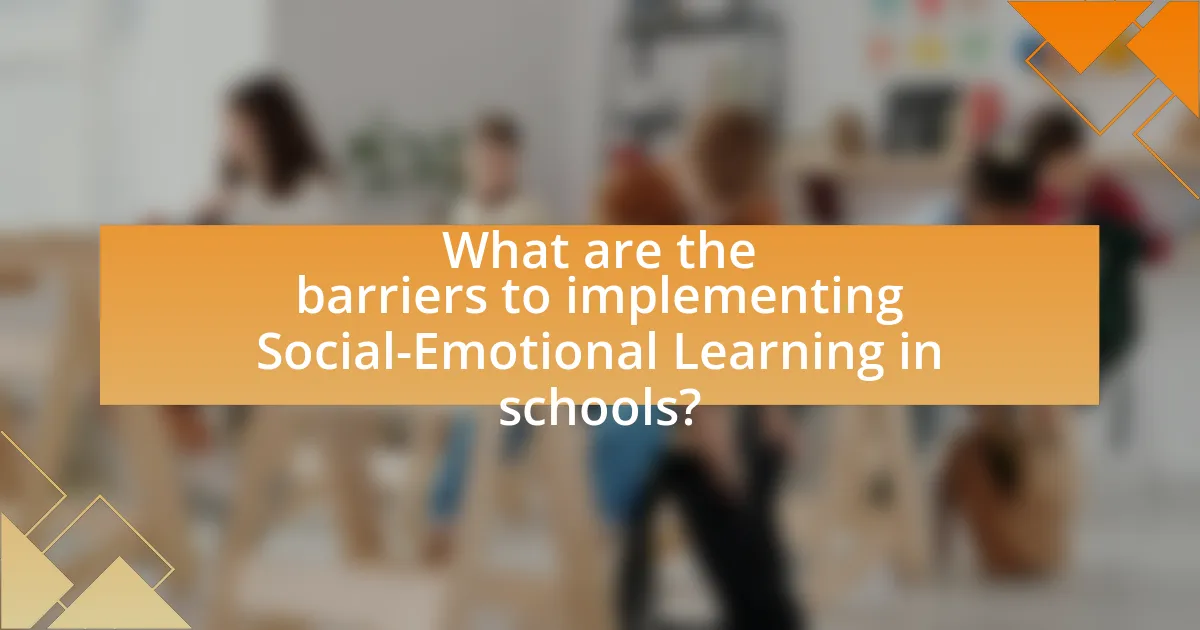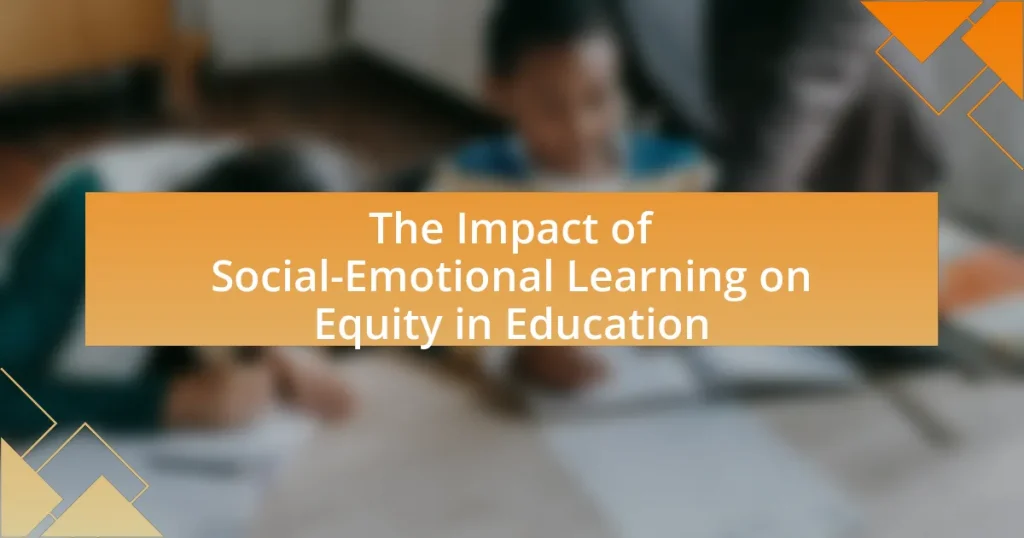The article examines the impact of Social-Emotional Learning (SEL) on equity in education, highlighting how SEL fosters inclusive environments that cater to diverse student needs. It discusses key principles of SEL, such as self-awareness and relationship skills, and their role in improving academic performance and reducing behavioral issues, particularly among marginalized groups. Research findings indicate that schools implementing SEL programs experience significant gains in student achievement and a decrease in dropout rates, thereby contributing to a more equitable educational landscape. The article also addresses challenges faced by diverse student populations and outlines strategies for educators to effectively integrate SEL into curricula, emphasizing the importance of community partnerships and policy support in enhancing SEL initiatives.

What is the Impact of Social-Emotional Learning on Equity in Education?
Social-Emotional Learning (SEL) positively impacts equity in education by fostering inclusive environments that support diverse student needs. SEL programs enhance students’ emotional intelligence, leading to improved relationships and reduced behavioral issues, which are crucial for marginalized groups. Research indicates that schools implementing SEL see increased academic performance and decreased dropout rates among disadvantaged students, as evidenced by a study from the Collaborative for Academic, Social, and Emotional Learning (CASEL) showing that SEL can lead to a 13% increase in academic achievement. This demonstrates that SEL not only addresses emotional and social skills but also contributes to leveling the educational playing field.
How does Social-Emotional Learning contribute to educational equity?
Social-Emotional Learning (SEL) contributes to educational equity by fostering an inclusive environment that addresses the diverse emotional and social needs of all students. SEL programs enhance students’ emotional intelligence, resilience, and interpersonal skills, which are crucial for navigating challenges in diverse educational settings. Research indicates that schools implementing SEL frameworks see improved academic outcomes, particularly for marginalized groups; for instance, a meta-analysis by Durlak et al. (2011) found that SEL interventions led to an 11 percentile-point gain in academic achievement. By equipping students with essential life skills and promoting a supportive school culture, SEL helps level the playing field, ensuring that all students have the opportunity to succeed regardless of their background.
What are the key principles of Social-Emotional Learning?
The key principles of Social-Emotional Learning (SEL) include self-awareness, self-management, social awareness, relationship skills, and responsible decision-making. These principles are designed to foster emotional intelligence and interpersonal skills, which are essential for students’ academic and personal success. Research indicates that SEL programs can lead to improved academic performance, better behavior, and enhanced emotional well-being, as evidenced by a meta-analysis conducted by Durlak et al. (2011) in the journal “Child Development,” which found that students participating in SEL programs showed an 11-percentile-point gain in academic achievement compared to their peers.
How do these principles relate to equity in education?
The principles of social-emotional learning (SEL) directly enhance equity in education by fostering inclusive environments that support diverse student needs. SEL promotes skills such as empathy, self-awareness, and relationship-building, which are essential for creating a classroom culture where all students feel valued and understood. Research indicates that schools implementing SEL programs see improved academic outcomes and reduced behavioral issues, particularly among marginalized groups, thereby narrowing achievement gaps. For instance, a study by Durlak et al. (2011) found that students participating in SEL programs demonstrated an 11-percentile-point gain in academic performance compared to their peers. This evidence underscores the role of SEL principles in advancing educational equity by addressing the emotional and social barriers that disproportionately affect underrepresented students.
Why is Social-Emotional Learning important for diverse student populations?
Social-Emotional Learning (SEL) is important for diverse student populations because it fosters inclusivity and enhances emotional intelligence, which are critical for navigating varied cultural contexts. SEL equips students with skills to manage emotions, set goals, and establish positive relationships, thereby promoting a supportive learning environment. Research indicates that SEL programs can lead to improved academic performance and reduced behavioral issues, particularly in diverse settings where students may face unique challenges. For instance, a meta-analysis by Durlak et al. (2011) found that students participating in SEL programs showed an 11 percentile-point gain in academic achievement compared to those who did not. This evidence underscores the significance of SEL in addressing the needs of diverse learners and promoting equity in education.
What challenges do diverse student populations face in education?
Diverse student populations face challenges such as language barriers, cultural differences, and socioeconomic disparities in education. Language barriers hinder effective communication and comprehension, making it difficult for non-native speakers to engage fully in the learning process. Cultural differences can lead to misunderstandings and a lack of representation in curricula, which may affect students’ sense of belonging. Socioeconomic disparities often result in unequal access to resources, including technology and extracurricular activities, further exacerbating educational inequities. According to the National Center for Education Statistics, students from low-income families are less likely to have access to advanced coursework, which limits their academic opportunities.
How can Social-Emotional Learning address these challenges?
Social-Emotional Learning (SEL) can address challenges in education by fostering emotional intelligence, resilience, and interpersonal skills among students. SEL programs enhance students’ ability to manage emotions, set goals, show empathy, and maintain positive relationships, which are crucial for overcoming barriers to learning and engagement. Research indicates that schools implementing SEL see improved academic performance and reduced behavioral issues, as evidenced by a meta-analysis conducted by Durlak et al. (2011), which found that students participating in SEL programs demonstrated an 11-percentile-point gain in academic achievement compared to their peers. This improvement in emotional and social competencies helps create a more equitable educational environment, allowing all students, regardless of background, to thrive.
What evidence supports the effectiveness of Social-Emotional Learning in promoting equity?
Social-Emotional Learning (SEL) effectively promotes equity by improving student outcomes across diverse demographics. Research indicates that SEL programs lead to significant improvements in academic performance, social skills, and emotional regulation, particularly for marginalized groups. For instance, a meta-analysis by Durlak et al. (2011) found that students participating in SEL programs showed an 11-percentile-point gain in academic achievement compared to their peers. Furthermore, SEL initiatives have been shown to reduce behavioral issues and improve school climate, which disproportionately benefits students from underrepresented backgrounds. A study by Jones and Bouffard (2012) highlights that SEL fosters inclusive environments, enabling all students to thrive regardless of their socio-economic status. These findings collectively demonstrate that SEL not only enhances individual student success but also contributes to a more equitable educational landscape.
What studies have been conducted on Social-Emotional Learning and equity?
Studies on Social-Emotional Learning (SEL) and equity include the research conducted by Durlak et al. (2011), which found that SEL programs significantly improve students’ social skills and academic performance, particularly benefiting marginalized groups. Another notable study by Jones et al. (2017) highlighted that SEL interventions can reduce disparities in educational outcomes by fostering a more inclusive school environment. Additionally, the Collaborative for Academic, Social, and Emotional Learning (CASEL) has published various reports emphasizing the importance of integrating SEL with equity-focused practices to address systemic inequalities in education. These studies collectively demonstrate that effective SEL implementation can promote equity by enhancing the emotional and social competencies of all students, especially those from disadvantaged backgrounds.
What outcomes have been observed in schools implementing Social-Emotional Learning?
Schools implementing Social-Emotional Learning (SEL) have observed improved student outcomes, including enhanced academic performance, better emotional regulation, and reduced behavioral issues. Research indicates that students participating in SEL programs show an average increase of 11 percentile points in academic achievement compared to peers who do not participate. Additionally, SEL implementation has been linked to a 20-30% reduction in classroom disruptions and disciplinary referrals, fostering a more conducive learning environment. These outcomes demonstrate the effectiveness of SEL in promoting both academic success and positive behavior among students.
How can educators implement Social-Emotional Learning to enhance equity?
Educators can implement Social-Emotional Learning (SEL) to enhance equity by integrating culturally responsive practices that address the diverse emotional and social needs of all students. This approach involves training educators to recognize and value the unique backgrounds of their students, fostering an inclusive environment where every student feels safe and supported. Research indicates that SEL programs, when tailored to reflect the cultural contexts of students, can lead to improved academic outcomes and reduced behavioral issues, thereby promoting equity in educational settings. For instance, a study by Durlak et al. (2011) found that effective SEL programs can significantly enhance students’ social skills and academic performance, particularly among marginalized groups.
What strategies can educators use to integrate Social-Emotional Learning into their curriculum?
Educators can integrate Social-Emotional Learning (SEL) into their curriculum by implementing explicit SEL instruction, fostering a supportive classroom environment, and incorporating SEL into academic content. Explicit SEL instruction involves teaching students skills such as self-awareness, self-management, social awareness, relationship skills, and responsible decision-making through structured lessons. Research shows that programs like the Collaborative for Academic, Social, and Emotional Learning (CASEL) have effectively improved student outcomes when SEL is explicitly taught.
Fostering a supportive classroom environment includes creating a culture of respect and empathy, where students feel safe to express their emotions and experiences. This can be achieved through practices such as restorative circles and peer mediation, which have been shown to enhance student relationships and reduce conflict.
Incorporating SEL into academic content means integrating social-emotional themes into subjects like literature, history, and science. For example, discussing characters’ emotions in literature or exploring ethical dilemmas in history can help students connect SEL concepts to their academic learning. Studies indicate that this integration not only enhances engagement but also reinforces the relevance of SEL in students’ lives.
How can schools measure the impact of Social-Emotional Learning on equity?
Schools can measure the impact of Social-Emotional Learning (SEL) on equity by utilizing quantitative and qualitative assessments that track student outcomes across diverse demographics. These assessments can include standardized surveys that evaluate students’ social-emotional competencies, academic performance, and behavioral incidents, disaggregated by race, socioeconomic status, and other relevant factors. For instance, research from the Collaborative for Academic, Social, and Emotional Learning (CASEL) indicates that effective SEL programs can lead to improved academic performance and reduced behavioral issues, particularly among marginalized groups. By analyzing this data, schools can identify disparities in SEL outcomes and adjust their programs to promote equity, ensuring that all students benefit from SEL initiatives.

What are the barriers to implementing Social-Emotional Learning in schools?
Barriers to implementing Social-Emotional Learning (SEL) in schools include insufficient training for educators, lack of funding, and resistance to curriculum changes. Educators often report feeling unprepared to teach SEL due to inadequate professional development opportunities, which can hinder effective implementation. Additionally, many schools face budget constraints that limit resources for SEL programs, making it difficult to integrate them into existing curricula. Resistance from stakeholders, including parents and school boards, can also pose challenges, as some may prioritize academic achievement over emotional and social development. Research indicates that these barriers can significantly impact the successful adoption of SEL initiatives, ultimately affecting the equity of educational outcomes for students.
What systemic issues affect the implementation of Social-Emotional Learning?
Systemic issues affecting the implementation of Social-Emotional Learning (SEL) include inadequate funding, lack of trained personnel, and insufficient integration into existing curricula. Inadequate funding limits resources for SEL programs, making it difficult for schools to provide comprehensive training and materials. A lack of trained personnel results in ineffective delivery of SEL content, as educators may not possess the necessary skills or knowledge to teach these concepts effectively. Furthermore, insufficient integration into existing curricula can lead to SEL being viewed as an add-on rather than a core component of education, which diminishes its impact on student development. Research indicates that schools with dedicated SEL programs see improved student outcomes, highlighting the importance of addressing these systemic barriers for effective implementation.
How do funding and resources impact Social-Emotional Learning initiatives?
Funding and resources significantly impact Social-Emotional Learning (SEL) initiatives by determining the quality and accessibility of programs implemented in educational settings. Adequate funding allows schools to hire trained personnel, develop comprehensive curricula, and provide necessary materials and training for educators. For instance, a study by the Collaborative for Academic, Social, and Emotional Learning (CASEL) found that schools with dedicated funding for SEL programs reported improved student outcomes, including better academic performance and enhanced emotional well-being. Conversely, insufficient resources can lead to poorly implemented SEL initiatives, limiting their effectiveness and accessibility, particularly in underfunded schools. This disparity in funding contributes to inequities in education, as students in lower-income areas may not receive the same level of support for their social-emotional development as their peers in more affluent districts.
What role do teacher training and professional development play?
Teacher training and professional development are essential for enhancing educators’ skills in implementing social-emotional learning (SEL) effectively. These programs equip teachers with the knowledge and strategies necessary to foster a supportive classroom environment that promotes equity in education. Research indicates that well-trained teachers are more adept at recognizing and addressing the diverse emotional and social needs of their students, which is crucial for creating inclusive learning spaces. For instance, a study by the Collaborative for Academic, Social, and Emotional Learning (CASEL) highlights that professional development focused on SEL leads to improved student outcomes, including increased academic performance and better social skills. Thus, teacher training and professional development play a pivotal role in integrating SEL into educational practices, ultimately contributing to greater equity in education.
How can schools overcome these barriers?
Schools can overcome barriers to social-emotional learning (SEL) by implementing comprehensive training programs for educators that focus on SEL strategies. Research indicates that when teachers are trained in SEL, they are better equipped to create supportive classroom environments, which enhances student engagement and emotional well-being. For instance, a study by Durlak et al. (2011) found that SEL programs significantly improve students’ social skills, attitudes, and academic performance. Additionally, schools can foster partnerships with community organizations to provide resources and support for students and families, addressing external factors that impact emotional learning. By prioritizing SEL in curricula and involving families in the process, schools can create a more equitable educational environment that supports all students.
What best practices exist for successful implementation of Social-Emotional Learning?
Successful implementation of Social-Emotional Learning (SEL) involves integrating SEL into the school curriculum, providing professional development for educators, and fostering a supportive school climate. Research indicates that schools that embed SEL into daily practices see improved student outcomes, including enhanced academic performance and reduced behavioral issues. For instance, a meta-analysis by Durlak et al. (2011) found that students receiving SEL instruction demonstrated an 11 percentile-point gain in academic achievement compared to those who did not. Additionally, ongoing training for teachers equips them with the skills to effectively teach and model SEL competencies, which is crucial for creating an environment conducive to learning. Establishing a positive school climate, characterized by strong relationships and a sense of belonging, further supports the successful implementation of SEL, as highlighted in the Collaborative for Academic, Social, and Emotional Learning (CASEL) framework.
How can community partnerships support Social-Emotional Learning efforts?
Community partnerships can significantly enhance Social-Emotional Learning (SEL) efforts by providing resources, expertise, and support systems that schools may lack. These partnerships can facilitate access to mental health professionals, after-school programs, and community-based activities that promote emotional well-being and social skills. For instance, research from the Collaborative for Academic, Social, and Emotional Learning (CASEL) indicates that schools with strong community ties report improved student engagement and emotional resilience. Additionally, partnerships with local organizations can offer training for educators on SEL practices, ensuring that the curriculum is effectively implemented and tailored to meet the diverse needs of students.

What future directions exist for Social-Emotional Learning and educational equity?
Future directions for Social-Emotional Learning (SEL) and educational equity include integrating SEL into academic curricula, enhancing teacher training, and utilizing data-driven approaches to assess student needs. Integrating SEL into curricula can foster a holistic educational environment that addresses both academic and emotional development, which is essential for equitable learning experiences. Enhancing teacher training ensures educators are equipped to implement SEL strategies effectively, promoting a supportive classroom atmosphere that benefits all students. Data-driven approaches, such as using assessments to identify social-emotional needs, can help tailor interventions to diverse student populations, thereby addressing disparities in educational outcomes. These directions are supported by research indicating that effective SEL programs can lead to improved academic performance and reduced behavioral issues, ultimately contributing to greater educational equity.
How can policy changes enhance the role of Social-Emotional Learning in education?
Policy changes can enhance the role of Social-Emotional Learning (SEL) in education by mandating its integration into curricula and providing funding for training educators. For instance, states like Illinois have enacted laws requiring SEL standards in K-12 education, which has led to increased implementation in classrooms. Research indicates that schools with structured SEL programs report improved student behavior and academic performance, demonstrating the effectiveness of such policies. Furthermore, allocating resources for professional development ensures that teachers are equipped to deliver SEL effectively, thereby fostering a supportive learning environment that promotes equity among students.
What legislative measures could support Social-Emotional Learning initiatives?
Legislative measures that could support Social-Emotional Learning (SEL) initiatives include the allocation of funding for SEL programs, the establishment of state standards for SEL curriculum, and the integration of SEL into teacher training requirements. Funding is crucial as it enables schools to implement and sustain effective SEL programs, evidenced by the Collaborative for Academic, Social, and Emotional Learning (CASEL) which highlights that schools with dedicated funding for SEL see improved student outcomes. State standards ensure that SEL is systematically taught across districts, promoting equity in access to these essential skills. Furthermore, requiring SEL training for educators prepares them to effectively teach and model these skills, as shown in research by the National Center for Education Statistics, which indicates that trained teachers are more successful in fostering a supportive learning environment.
How can advocacy groups influence the integration of Social-Emotional Learning?
Advocacy groups can influence the integration of Social-Emotional Learning (SEL) by promoting policy changes, providing resources, and raising public awareness. These organizations often engage with educational stakeholders, including policymakers and school administrators, to highlight the importance of SEL in fostering equitable educational environments. For instance, research from the Collaborative for Academic, Social, and Emotional Learning (CASEL) indicates that effective SEL programs can improve student outcomes, particularly for marginalized groups. By leveraging data and success stories, advocacy groups can effectively argue for the inclusion of SEL in curricula and funding initiatives, thereby shaping educational practices and policies to support all students.
What are the implications of Social-Emotional Learning for future educational practices?
Social-Emotional Learning (SEL) will significantly shape future educational practices by fostering a holistic approach to student development. SEL emphasizes the importance of emotional intelligence, resilience, and interpersonal skills, which are essential for academic success and personal well-being. Research indicates that schools implementing SEL programs see improvements in student behavior, academic performance, and mental health outcomes. For instance, a meta-analysis by Durlak et al. (2011) found that students participating in SEL programs demonstrated an 11-percentile-point gain in academic achievement compared to their peers. This evidence supports the notion that integrating SEL into curricula can enhance educational equity by addressing the diverse needs of students, particularly those from marginalized backgrounds. Consequently, future educational practices will likely prioritize SEL to create inclusive environments that promote both academic and social success.
How might technology play a role in advancing Social-Emotional Learning?
Technology can significantly advance Social-Emotional Learning (SEL) by providing interactive platforms that facilitate emotional awareness and social skills development. For instance, digital tools such as apps and online programs can offer personalized feedback and simulations that help students practice empathy and conflict resolution in a safe environment. Research indicates that technology-enhanced SEL programs can lead to improved emotional regulation and interpersonal skills, as evidenced by a study published in the Journal of Educational Psychology, which found that students using SEL-focused digital tools showed a 23% increase in social skills compared to those who did not. This integration of technology not only makes SEL more accessible but also engages students in a manner that aligns with their digital experiences, thereby promoting equity in educational opportunities.
What trends are emerging in Social-Emotional Learning research and practice?
Emerging trends in Social-Emotional Learning (SEL) research and practice include a focus on integrating SEL into academic curricula, the use of technology for SEL delivery, and an emphasis on culturally responsive practices. Research indicates that integrating SEL into academic subjects enhances student engagement and academic performance, as shown in studies like the Collaborative for Academic, Social, and Emotional Learning (CASEL) framework, which highlights the positive correlation between SEL and improved educational outcomes. Additionally, the rise of digital platforms for SEL, particularly during the COVID-19 pandemic, has facilitated remote learning and accessibility, allowing for broader reach and engagement. Furthermore, culturally responsive SEL practices are gaining traction, recognizing the importance of addressing diverse student backgrounds and experiences, which is supported by findings from the National Commission on Social, Emotional, and Academic Development that emphasize the need for inclusivity in SEL initiatives.
What practical steps can educators take to enhance Social-Emotional Learning for equity?
Educators can enhance Social-Emotional Learning (SEL) for equity by implementing culturally responsive teaching practices. Culturally responsive teaching acknowledges and incorporates students’ diverse backgrounds, which fosters a sense of belonging and respect. Research shows that when students see their cultures reflected in the curriculum, their engagement and academic performance improve, leading to equitable outcomes. Additionally, educators should provide training on implicit bias and social-emotional competencies, which equips them to better support all students, particularly those from marginalized communities. Studies indicate that professional development in these areas can significantly enhance educators’ effectiveness in promoting SEL. Finally, creating safe and inclusive classroom environments where students can express their emotions and experiences openly is crucial; this approach has been linked to improved mental health and academic success among diverse student populations.
How can educators create inclusive environments that foster Social-Emotional Learning?
Educators can create inclusive environments that foster Social-Emotional Learning (SEL) by implementing culturally responsive teaching practices and promoting a sense of belonging among all students. Culturally responsive teaching involves recognizing and valuing the diverse backgrounds of students, which enhances their engagement and emotional well-being. Research indicates that when students feel respected and understood, their social-emotional skills improve, leading to better academic outcomes (Gay, 2010). Additionally, fostering a sense of belonging can be achieved through collaborative activities that encourage peer relationships and support networks, which are essential for developing empathy and emotional regulation. Studies show that inclusive environments that prioritize SEL contribute to reduced behavioral issues and increased academic performance, demonstrating the positive impact of such practices on equity in education (Durlak et al., 2011).
What resources are available for educators to support Social-Emotional Learning initiatives?
Educators can access a variety of resources to support Social-Emotional Learning (SEL) initiatives, including curriculum guides, professional development programs, and online platforms. For instance, the Collaborative for Academic, Social, and Emotional Learning (CASEL) provides a comprehensive framework and resources for implementing SEL in schools. Additionally, organizations like the Yale Center for Emotional Intelligence offer training programs and materials focused on integrating emotional intelligence into educational practices. Research indicates that effective SEL programs can lead to improved academic performance and enhanced student well-being, reinforcing the importance of these resources in promoting equity in education.



